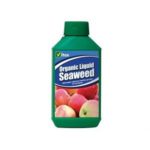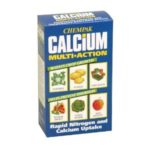Knowing what tomato plants like is essential for a good crop, so feeding your plants the right tomato food, at the right time, is important.
Tomato plants require only small amounts of food when they are young, gradually increasing throughout their lives to a lot of food (nutrients) when they are mature and producing tomatoes.
Seedlings and Young Plants
There is enough food in multi-purpose compost (potting compost) to not have to feed small plants at all.
As plants are potted into bigger pots, with more compost containing nutrients, giving extra nutrients isn’t really necessary.
This is sometimes frustrating for the beginner, and the rest of us who want to be over-generous to our little seedlings by giving them lots of TLC and food!

A Seaweed Tonic
However, a tonic that can be given to small tomato plants is organic liquid seaweed extract. This can be applied as a foliar spray, it is organic and helps give a boost to encourage lush green leaves. It also boosts the immune system of plants helping them to fight off disease.
When Buds Start To Open
My plants leave their last pot to go into their final position – a large container or grow bag – when the flowers begin to open. It’s at this stage that they need access to plenty of nutrients.
This happens automatically because a container full of multi-purpose compost or grow bag contains a lot of food, so they won’t need to be given any additional nutrients for a few weeks.
Over-feeding, especially with nitrogen, just before they reach the flowering stage (as buds are about to open) will encourage very bushy, leafy plants – not what you want, because you now want to encourage flowers. It will turn a greenhouse into a leafy jungle – Dr Livingstone I presume?
What Does Your Tomato Food Contain?
The usual ingredients are N-P-K which stands for nitrogen-phosphorous-potassium. The amount of potassium is usually higher because it is needed for flowering and fruiting.
- Nitrogen is for leaf growth
- Phosphorous for root growth
- Potassium for flower and fruit growth (All three generally speaking)
Other Ingredients
Magnesium, seaweed extract and wetting agents may also be found in tomato food.
Magnesium is needed by the fruit and enhances the flavour, seaweed extract is an organic stimulant and contributes to the general health of plants and a wetting agent helps the distribution of moisture throughout the entire root or soil area. The wetting agent is useful because it helps prevent blossom end rot … a problem caused by a lack of calcium.

Avoiding Blossom End Rot
I give extra calcium to my medium and large varieties as a foliar spray. This is very effective at reducing Blossom End Rot. I once had a lovely Yellow Plum bush variety that I grew in a large pot and every tomato was effected by BER. Since I started using Chempak Calcium as a foliar spray, I get hardly any tomatoes effected.
Not all tomato food contains trace elements because most of these elements are only needed in small amounts and can already be found in compost/soil.
A general purpose food like Miracle Grow is helpful as a supplement and may be given when plant leaves look as if they need help! Once again, given as a foliar spray will get nutrients into a plant’s system faster than by applying at roots.
Professional growers feed at every watering, but this is not recommended unless you have a professional set-up and can monitor how much your plants receive – it’s usually best to follow the advice on the food container.
However, when plants are fruiting it may be suitable to give them half the amount, twice as often.
Little and often is the best way, in my experience, to feed plants that are producing fruit. If in doubt, it is usually best to give a bit less than a bit more, because giving too much can change the chemical balance within the soil and cause complications.


Adrienne
My tomatoes have ber, I can’t seem to shake it. I’ve used basalt meal, milk and seaweed feed and tomato feed… still getting it. 2 of my plants have water reservoirs built in and the other 2 have the water sticks I fill everyday and put in the soil. We are having a heatwave in the Netherlands its the only reason I can think this is happening as they are getting plenty of water and nutrients. My tomato varieties are indigo rose and german strawberry, thinking next year I will have to go for ber resistant types such as cherry tomatoes. If in the meantime anyone has a miracle cure? I would love to know, hoping to get some sort of harvest this year…
Trevor Coombe
Have got some liquid seaweed feed on order but my question is how to apply it?
I know it’s a foliar spray but is it a case of just a light spraying or drench the leaves?
Many thanks in advance!
Trevor.
Nick
Hi Trevor,
You can use it as a root drench or a foliar spray – just follow the directions on the pack.
I tend to use it as a foliar spray because I think it gets to where it’s needed faster!
Best wishes,
Nick
Mark D
Most tomato foods for fruiting plants are relatively high in potassium, which of course promotes fruiting. Doff’s liquid tomato feed, for instance, is NPK 4:5:8. Organic growers can make comfrey tea, which is said to be a good source of potash, but does tend to stink!
Tomatoes are said to need magnesium too. Check on the label before you buy tomato food as some leading brands don’t include extra Mg, while some cheaper ones do! Otherwise you can dissolve a pinch of Epsom salts (magnesium sulphate). Organic growers could use Dolomitic limestone, which is also a source of Mg, in their growing medium.